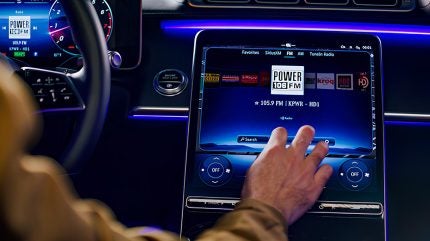
The increasing demand for in-vehicle infotainment systems is impacting the automotive industry, transforming the driver experience and expectations. Consumers expect simple, personalised content within their vehicles, offering the latest technology and features.
Xperi, a company specialising in developing software for consumer electronics and connected cars, has developed the DTS AutoStage Video Service Powered by TiVo. The DTS AutoStage allows consumers to access a personalised entertainment experience, including radio, music, TV shows, movies, games and more.
We spoke to Geir Skaaden, chief products and services officer, to learn more about the growing demand for in-vehicle entertainment and what it means for the automotive industry.

Just Auto (JA): Could you discuss Xperi’s DTS AutoStage video service and what it offers?
Geir Skaaden (GS): Consumers are demanding more content in the car than ever before. DTS AutoStage is a global entertainment platform for the connected car that makes it easy for consumers to discover and engage with the full spectrum of their entertainment preferences from one unified place.
Building on the foundation of DTS AutoStage, the DTS AutoStage Video Service Powered by the TiVo platform is the ultimate in-car video entertainment experience. The AI-powered video platform brings a personalised, content-first experience to the connected car, delivering premium content across live TV, news, sports, podcasts, movies and more, on vehicle screens.
By prioritising easy discovery of the multitude of content and formats consumers demand, our platform equips automakers with the agility to transform customer entertainment experiences and build deeper, more engaging relationships.
What impact does the growing demand for vehicle entertainment systems have on the automotive industry?
The rise of in-car entertainment is really changing the game for the automotive industry. Cars aren’t just about getting from point A to point B any longer; they’re becoming personalised, connected spaces where people expect the same kind of media experience they get at home. And that shift is having a big impact. In fact, it is estimated that the global in-car infotainment market size will reach $35.4 billion by 2030.
The rise of in-car entertainment is really changing the game for the automotive industry.
Most vehicles on the market today come equipped with a front seat screen. In-dash screens began as a way to provide infotainment to the driver primarily, while rear-seat screens initially were intended to deliver video to back seat passengers, but this has quickly evolved as more vehicles became equipped with 5G networks, enabling entertainment systems to connect in-car more directly.
We’re seeing vehicles turn into media-rich environments and that’s pushing automakers to think differently. It’s no longer just about horsepower or design, but about software, connectivity and the kind of content experiences they can offer. Much like the early days of connected TV, there’s a much bigger opportunity here, not just to improve the user experience, but to actually turn the car into a meaningful, monetisable touchpoint in the broader entertainment ecosystem. So, for automotive OEMs, it’s a chance to redefine the in-car experience, and build new kinds of value through content, partnerships, and innovation.
How has AI and personalisation transformed the in-car experience?
AI and personalisation are redefining what’s possible for in-car entertainment. It’s no longer a one-size-fits-all setup. One of the standouts features of an independent media platform is its advanced, unbiased search and recommendation capabilities, powered by sophisticated algorithms that learn from viewing habits and provide personalised suggestions tailored to each user’s preferences. As such, content aligns more with their interests and makes it effortless to discover and enjoy new entertainment – at home or in the car. Whether it’s curated music and video recommendations or location-based content, everything feels relevant and intuitive. AI-powered real-time data enhances the in-car display by intelligently surfacing relevant artists, tracks, albums and channel details tailored to the listener.
AI and personalisation are redefining what’s possible for in-car entertainment
What opportunities does this present for companies and broadcasters to engage with their audiences?
DTS AutoStage enables broadcasters, streaming platforms, advertisers and content creators to reach audiences in their cars in a way that feels natural and non-intrusive, connecting with them in their everyday routines, just like at home.
Radio stations will see success by becoming early adopters of AI tools and pushing for a more immersive media experience throughout the car, inclusive of video. In order to be able to drive meaningful adoption, video content in the car can be snackable, real-time and focused on relevant, local updates. Radio stations already do this in audio-only format, so if they can start leveraging video, they’ll help drive this rich, in-car entertainment experience.
Car manufacturers also have a big opportunity to redefine their brand and user experience, by becoming the centre of an entire ecosystem of services that enhance the car and entertainment journey. It’s a shift that’s also driving new advertising and monetisation opportunities, whether through subscriptions, ad-supported content, or brand partnerships.
What do you see the future holding for this area of the industry?
As screens become both bigger size-wise and a bigger part of the in-car experience, vehicles are shaping up to be the next major digital media environment. We’ll see in-car entertainment turn everyday journeys into richer, more personalised experiences. As vehicles become more connected and autonomous, we’ll see a big shift toward immersive, screen-driven environments designed for both drivers and passengers.
The rise of EVs and self-driving technology will also help the growth of In-car entertainment. Big, high-quality screens have become an expectation in EVs due to the longer EV charging times increasing demand for engaging content. Autonomous driving will also open opportunities for more immersive in-car media consumption, as there’ll be a completely captive audience with few distractions.
The car will increasingly feel more like an extension of the home — a place where entertainment, technology, and mobility come together in a way that’s intuitive and engaging. It’s about richer content, seamless continuity, and smarter recommendations tailored to the individual wherever they are.








